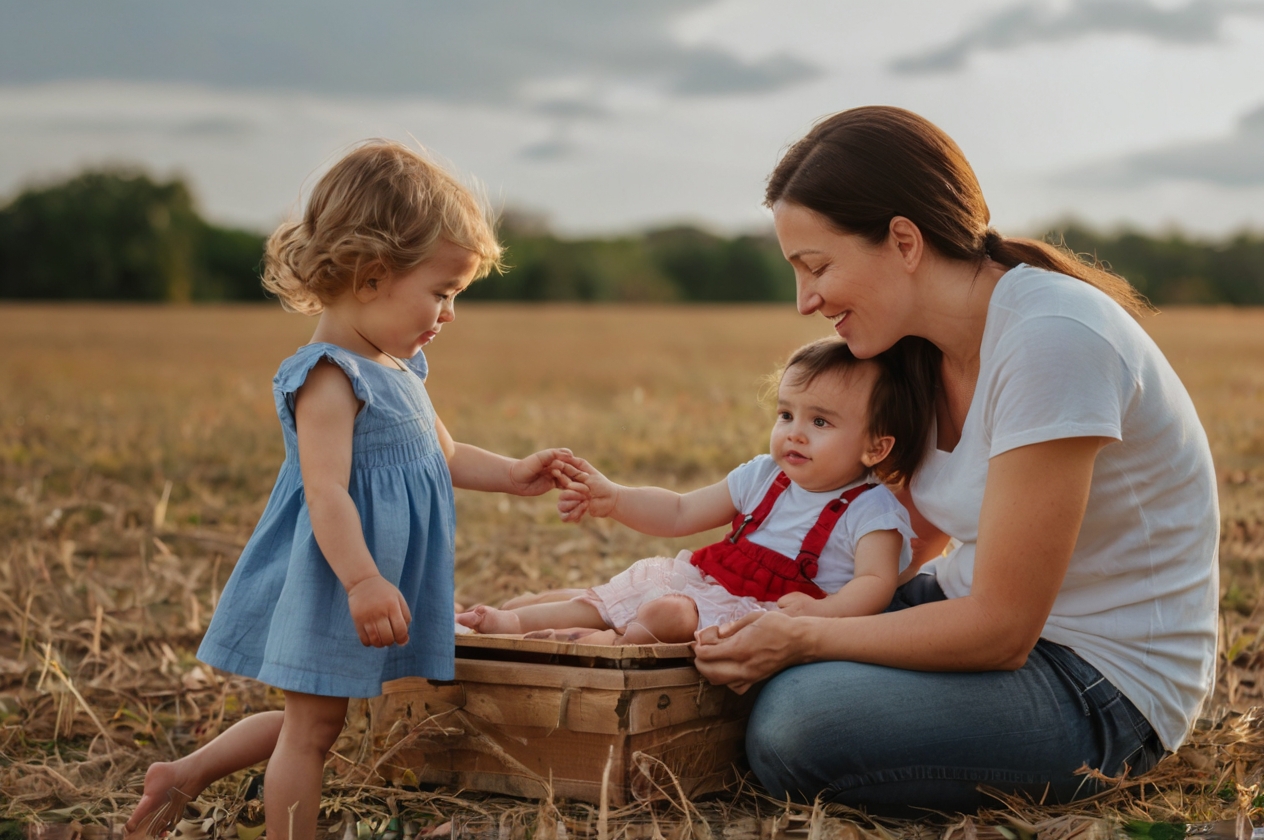
Attachment styles in children are heavily influenced by the way they interact with their caregivers, especially during their early years.
These interactions play a crucial role in shaping a child’s sense of security and trust in their relationships.
Essentially, the quality of these interactions can have a significant impact on how a child forms attachments to others throughout their life.
The Four Attachment Styles in Children
Understanding the different attachment styles in children is key to recognizing and addressing their emotional needs.
Let’s delve deeper into each attachment style:
Secure attachment
Children with a secure attachment style feel safe and loved by their caregivers.
They trust that their needs will be met and are confident exploring their environment.
This healthy attachment style provides a strong foundation for building positive relationships with others and developing a sense of independence.
Insecure-avoidant attachment
Children with an insecure-avoidant attachment style may appear independent and self-sufficient on the surface.
However, they often suppress their need for emotional closeness and intimacy with their caregivers.
This can lead to challenges in regulating emotions and forming deep connections with others later in life.
Insecure-ambivalent attachment
Children with an insecure-ambivalent attachment style crave constant reassurance and attention from their caregivers.
They may cling to their caregivers anxiously, fearing abandonment or rejection.
This attachment style can result in difficulties with emotional regulation and forming healthy relationships characterized by mutual trust and respect.
Disorganized attachment
Children with a disorganized attachment style struggle to form a consistent attachment pattern due to inconsistent or traumatic caregiving experiences.
They may display a mix of avoidant and ambivalent behaviors, alternating between seeking comfort and withdrawing from their caregivers.
This attachment style can lead to challenges in regulating emotions and establishing secure relationships in adulthood.

How Attachment Styles Form
Attachment styles are like the emotional blueprints that children start sketching in their early years, largely through their interactions with their caregivers, usually their parents.
Responsive care
The cornerstone of secure attachment lies in responsive caregiving.
This means that caregivers are attuned to their child’s needs and consistently respond promptly.
They provide comfort in times of distress, cheer for achievements, and offer guidance as the child explores their surroundings.
Through this dependable care, children learn that they are valued, their emotions are acknowledged, and their needs are important.
Emotional availability
Another crucial factor in attachment formation is emotional availability.
Emotionally available caregivers are not just physically present but also mentally engaged.
They create a safe space where a child’s emotions are heard, understood, and validated.
This emotional connection fosters the child’s ability to recognize and manage their own feelings effectively.
Early experiences
Unfortunately, traumatic events like neglect, abuse, or frequent separations from caregivers can disrupt the attachment process.
These experiences can lead to the development of insecure attachment styles, where children may struggle with trust, intimacy, and emotional regulation.
Temperament
A child’s natural temperament also influences attachment formation.
Some children are naturally more adaptable, making it easier for them to adjust to different caregiving styles.
Others may be more sensitive, requiring consistent and sensitive care to develop a secure attachment.

Recognizing Your Child’s Attachment Style
Recognizing your child’s attachment style can be challenging, but there are several signs you can look out for:
Pay attention to their emotions
Take the time to recognize and validate your child’s emotions.
When they’re upset, acknowledge their feelings and let them know you understand.
By validating their emotions, you help them feel seen and heard, which is essential for building a secure attachment.
Notice their behaviors
Observe your child’s behaviors and patterns in their interactions with you and other caregivers.
Do they seek comfort and closeness when they’re upset, or do they withdraw and avoid contact?
Paying attention to these cues can give you valuable insights into their attachment style and emotional needs.
Reflect their feelings
Reflecting your child’s feelings back to them can help them develop important emotional regulation skills.
When they express sadness, anger, or joy, mirror their emotions and let them know you understand how they’re feeling. Th
is validation helps them learn to manage their emotions in a healthy way.
Be consistent and responsive
Consistency and responsiveness are key to fostering a secure attachment style.
Make an effort to be consistent in your interactions with your child and respond promptly to their needs.
This helps them feel safe and secure in their relationship with you, which lays the foundation for healthy emotional development.

The Impact of Attachment Styles
The impacts of attachment styles in children are significant and can influence their emotional, social, and cognitive development throughout their lives.
Here are some key impacts of attachment styles in children:
Secure attachment
- Positive personality development: Securely attached children tend to develop better personalities, with higher levels of self-esteem, confidence, and emotional regulation.
- Better relationships: Securely attached children tend to form better relationships with others, including peers and romantic partners, and are more likely to develop long-term, fulfilling relationships.
- Resilience and adaptability: Securely attached children are more resilient and adaptable, better equipped to handle stress and adversity.
- Improved mental health: Securely attached children are less likely to experience mental health issues such as anxiety and depression.
Avoidant attachment
- Difficulty with emotional intimacy: Avoidantly attached children may struggle with emotional intimacy and have difficulty forming close, meaningful relationships.
- Increased stress: Avoidantly attached children may experience increased stress and anxiety due to their avoidance of emotional intimacy.
- Difficulty with trust: Avoidantly attached children may struggle with trust and may have difficulty forming trusting relationships.
Ambivalent attachment
- High levels of anxiety: Ambivalently attached children tend to experience high levels of anxiety and insecurity.
- Over-dependence on caregivers: Ambivalently attached children may become overly dependent on their caregivers, leading to difficulties in forming independent relationships.
- Difficulty with emotional regulation: Ambivalently attached children may struggle with emotional regulation, leading to intense emotional responses.
Disorganized attachment
- Difficulty with emotional regulation: Disorganized attached children may struggle with emotional regulation, leading to intense emotional responses.
- Increased stress: Disorganized attached children may experience increased stress and anxiety due to their disorganized attachment style.
- Difficulty with trust: Disorganized attached children may struggle with trust and may have difficulty forming trusting relationships.

Tips for Parents to Foster a Secure Attachment Style
Fostering a secure attachment style in children is crucial for their emotional well-being and social development.
Here are some tips for parents to nurture a secure attachment with their child:
Be consistent and responsive
Consistency and responsiveness create a sense of safety and predictability for children.
When caregivers consistently meet their child’s needs and respond promptly to their cues, children learn to trust and rely on their caregivers for support and comfort.
Spend quality time with your child
Quality time spent engaging in activities your child enjoys strengthens your bond and fosters a sense of security.
Whether it’s playing games, reading books, or simply talking and listening to your child, these interactions build a strong foundation for a secure attachment.
Use positive discipline
Positive discipline focuses on teaching and guiding children rather than punishing or scolding them.
By setting clear boundaries and providing constructive feedback, parents help children develop self-regulation skills and a positive self-image.
Be present and attuned
Being present and attuned to your child’s needs and emotions is essential for building a secure attachment.
Pay attention to your child’s cues, listen actively, and respond empathetically.
This helps children feel seen, heard, and understood, fostering a deep sense of trust and security.

Practice emotional regulation
Children learn emotional regulation skills by observing and imitating their parents’ behavior.
Model healthy emotional regulation by expressing your own emotions in a calm and constructive manner.
Provide emotional support and guidance to help your child navigate their own feelings effectively.
Encourage independence
Encouraging independence is important for fostering a child’s sense of self and confidence.
Allow your child to explore and make choices independently, while providing emotional support and reassurance along the way.
Balancing independence with emotional support helps children feel empowered and secure in their abilities.
Practice mindfulness
Mindfulness can help parents stay present and attuned to their children’s needs.
By practicing mindfulness, parents can cultivate a deeper connection with their child and respond more effectively to their emotional cues.
This promotes a secure attachment and strengthens the parent-child bond.
Be realistic and patient
Understanding your child’s needs and abilities, and being patient with their development, is essential for fostering a secure attachment.
Celebrate their successes, support them through challenges, and offer unconditional love and acceptance.
By being realistic and patient, you create a nurturing environment where your child feels secure and supported in their growth and development.

Conclusion
Attachment styles in children are a crucial aspect of their emotional and social development.
Understanding the four attachment styles in children and how they form can help parents recognize their child’s attachment style and take steps to foster a secure attachment style.
By being consistent, responsive, practicing emotional regulation, encouraging independence, and practicing mindfulness, parents can help their children develop a secure attachment style and set them up for a lifetime of emotional and social well-being.
FAQs
Attachment style in children refers to the way they attach to their caregivers and the quality of these interactions.
Attachment styles are shaped by the interactions children have with their caregivers, particularly during the early years of life.
The four attachment styles in children are secure, insecure-avoidant, insecure-ambivalent, and disorganized.
Parents can foster a secure attachment style by being consistent and responsive, practicing emotional regulation, encouraging independence, and practicing mindfulness.



